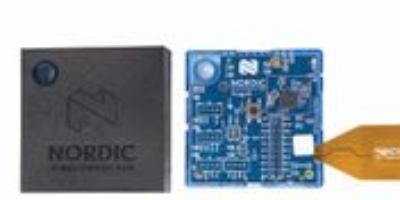Development kit integrates sensors for Bluetooth IoT devices
A development kit from Nordic Semiconductor is based on Nordic’s nRF52832 Bluetooth low energy system-on-chip (SoC). The, Nordic Thingy:52 development kit incorporates nine different sensors, a microphone and speaker. Nordic Semiconductor claims that it enables app developers to configure, test, and demonstrate Bluetooth low energy internet of things (IoT) devices linked to mobile apps and cloud platforms without needing radio frequency (RF) firmware coding skills or development tools
Nordic Thingy:52 is a single-board Bluetooth 5-compatible, Bluetooth low energy development kit that offers ‘out-of-the-box’ wireless configuration from smartphone apps and the cloud.
Using it, an app developer with no firmware coding expertise or high-level development tools can quickly design and demonstrate IoT devices, and associated mobile device and internet apps. The app developer, continues Nordic, can quickly and easily configure the development kit’s embedded application over the provided Bluetooth interface from a mobile device.
The development kit is based on Nordic’s nRF52832 Bluetooth low energy SoC which combines a 64MHz, 32-bit ARM Cortex M4F microprocessor with a 2.4GHz multi-protocol radio (supporting Bluetooth 5, ANT and proprietary 2.4GHz RF software), plus 512kbyte flash memory and 64kbyte random access memory (RAM). The nRF52832 SoC runs Nordic’s S132 SoftDevice, an RF software stack that can support up to 20 concurrent connections in a variety of Bluetooth low energy role combinations.
Nordic Thingy:52’s printed circuit board (PCB) is housed in a 60 x 60mm plastic and rubber case which includes a USB connector to charge the device’s Li-ion battery. The development kit incorporates a built-in digital microphone and speaker, a movement sensor (nine-axis including accelerometer, gyroscope and magnetometer),low power wake up accelerometer; and pressure, temperature, humidity, air-quality, and colour sensors. Nordic Thingy:52 is supplied with example firmware, and iOS and Android Bluetooth low energy connectivity apps. Nordic has also made additional source-code app software available on GitHub.
App developers can quickly develop IoT devices for a range of applications using Nordic Thingy:52, says Nordic Semiconductor. Altering parameters such as the air-quality sensor’s sample rate, or switching on the colour sensor, for example, can be simply achieved via an over-the-air instruction from a smartphone or internet app with no need to interact directly with Nordic Thingy:52’s firmware code. More complex IoT applications, can be implemented equally easy, assures the company. For example, Nordic Thingy:52 can be configured to change its LED’s colour in response to voice commands directed at a personal assistant such as Amazon’s Alexa. The voice command triggers Alexa to contact a cloud platform, which in turn instructs an inexpensive internet-connected router to wirelessly forward the command to activate Nordic Thingy:52.
The development platform is also cloud-platform compatible. For example, a Nordic Thingy:52 fixed to a door could report the door opening to a cloud platform which then triggers a text to a smartphone. Or it could be commanded to activate connected products such as Philips Hue smart lighting when the cloud platform registers the home owner’s smartphone is near Nordic Thingy:52’s location.




